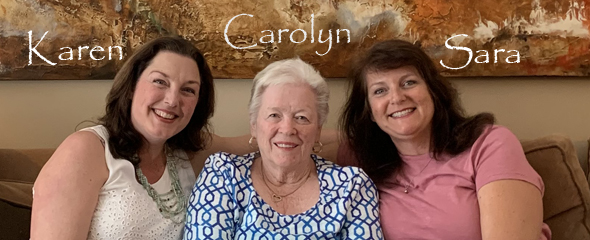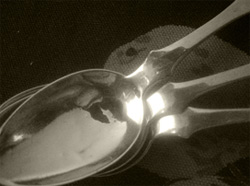Long ago, when I was a teenager, my best friend lived a few doors from me. Linda and I were fast friends for all these years. Sadly, Linda passed away of pneumonia about 2 years ago. She was severely handicapped and lived most of her young life at home, being home schooled. She eventually broadened her world, learned to drive a specially outfitted van with hand controls and a lift/gate, attended her last year of high school at the one I attended too, then she attended college, had several jobs too. Her dad was a Navy dentist; Van was a stay-at-home mom to Linda and her sister Joan. Once in awhile Linda’s mother Van and her dad would entertain a big group of friends, and one of her favorite things to prepare was lamb curry. This lamb curry. (It was my first introduction to lamb, as my dad wouldn’t eat lamb. He wouldn’t eat chicken, either. So my mom was kind of stuck with pork, beef and only very occasionally some fish.) Anyway, as we got old enough to handle knives, Linda’s mom would recruit us to help prepare the condiments. And they are legion. Van usually served about 25-30 condiments. So our job was to clean, dry, mince, chop and put things in tiny bowls, covered with waxed paper (I don’t think we had plastic wrap back then) and carefully refrigerated or stacked on a large tray, ready to serve. Van always made the curry the day before – the flavors are so much better with an overnight chill.
Over the years I’ve made this dish a multitude of times, always for guests because it makes a lot, and usually I’d serve about 10 condiments. Lamb lends itself well to a curry style sauce. And it’s not difficult to make. I’ve just not made it since I’ve been writing my blog. No real reason. Hence I don’t have a photo of it and needed to use someone else’s (at top).
To cut to present day. A couple of months ago I was asked if I’d be willing to do a food oriented speech/talk and/or food demo on zoom, for my branch of AAUW (American Association of University Women), an organization I’ve been in since my 20s. First, it was discussed about Christmas cookies. Ho hum. And I’m trying not to bake them since I’m a family of one. My friend Ann, who was talking to me about this, asked if I’d cooked anything unusual recently. Oh, yes I had. That was the Food Cart Curried Chicken. And the Curried Shepherd’s Pie (click links in next paragraph). So I suggested I do a talk about curry. Ann thought that was a good idea.
I did some online research and wrote up my speech. Ann had hoped I could do a food demo on zoom, but with only 25-30 minutes to talk, I thought that was not feasible. Plus, lighting would be a problem (this was a nighttime zoom session). I ended up propping up my iPad a few feet away on the island, turned on the lights over my head, set up all of my props (various curry powders, and individual ingredients that go into them). And at the end, in talking about the two dishes I had made, the Food Cart Curried Chicken plus my recent Curried Shepherd’s Pie, I pulled them out of the oven and moved them closer to the iPad, steaming hot and tried to scoop up a big spoonful, so the guests could see how delicious they looked.
I talked about the history of curry – starting in India – then incorporating some of the surrounding countries, then into Japan (the Japanese fell head over heels in love with curry when it was introduced to their culture a long time ago). I talked about the Colonial Period in India, when British officers were running the country. About how they hired local cooks (usually men), and when they were transferred to a new station, sometimes their cooks with them, as well as the spice combination that cook used. At the new post, new British military families would be introduced to the curry of the last place, etc. Eventually curry made its way to the United States, probably to Savannah, or Charleston, and in the early decades of the last century, the south was introduced to a pivotal dish called Country Captain. I also mentioned my friendship with Kunda, my microbiologist friend, who taught me how to make Shrimp Khichdi, a favorite in her family. And about the gift Kunda made to me, a bag of her mother’s garam masala (also a combination of specific herbs and spices). Kunda’s family in India makes it once a year, it’s an all-day family work-party gathering, and one of her family usually flies to California to visit Kunda and that person is the courier of Mom’s garam masala.
You know, of course, that “curry powder” isn’t a powder made from a curry tree. Right? Curry powder is a combination of spices (also can be called a masala), and probably every curry cook has his/her own special mixture. I talked about the heat in curry (which can be mild to hot, to very hot). I’m certainly no expert on curry – I’m a white Anglo-Saxon female with Scottish, Irish, English and Welsh roots, but gosh, do I ever love curry. My speech went well, so many people told me. I went long – nearly an hour. There were numerous questions at the end, and then I got to eat my curry. Yum.
So here’s the recipe below.
printer-friendly PDF and MasterCook file (click link to open recipe)
* Exported from MasterCook *
Indian Lamb Curry
Recipe By: An old recipe from a family friend, Van Canon, c. 1955
Serving Size: 12
1 large leg of lamb
3 teaspoons salt
3 1/2 tablespoons curry powder — or more to taste
2 tablespoons ghee — or unsalted butter
15 ounces coconut milk
2 cups lamb broth — from the lamb bone
2 cups hubbard squash — peeled, chopped, or use acorn squash or eggplant
1/4 cup lemon juice
8 medium onions — finely chopped
3 whole garlic cloves — minced
1/4 cup vegetable oil
1 cup evaporated milk
1 tablespoon sugar
8 medium Granny Smith apples — peeled, chopped
1/3 cup raisins — either black or golden
1/2 cup shredded coconut meat — unsweetened
For serving: fluffy basmati rice
1. Cut meat off the bone, discarding larger pieces of fat. Set aside the meat.
2. In a stock pot add water to cover the lamb bone and cook for a few hours, covered. You want to have at least 3 cups of broth. You may add some celery, onion and carrot to the mixture if you have it.
3. Cut the meat into bite-sized pieces. Sprinkle the meat with salt, pepper and all the curry powder and use your hands to massage the seasonings into all sides of the chopped lamb.
4. Melt ghee (or butter) in a large, heavy pot. Add onions first, saute over medium heat for about 10 minutes, then add garlic. Continue cooking for one minute only. Don’t allow the mixture to brown. Remove mixture to a bowl and set aside.
5. Add oil to the same pot and brown the meat in batches (if you crowd it, the meat will steam rather than brown). Once all the meat has been browned, add the onion mixture, coconut milk, lamb broth, evaporated milk and sugar. Bring to a boil, reduce heat and simmer mixture for about 30 minutes.
6. Add apples, squash, raisins, coconut, lemon juice, and cook for about 2 hours, covered. Taste for seasonings. This is best if made the day before and reheated. Serve with lots of condiments. Mixture freezes well.
CONDIMENTS: (this is a list of 30) in my order of importance: chopped fresh pineapple, coconut shreds, peanuts or cashews, chopped egg white and yolks, green onions, fruit chutney and crumbled bacon. Other condiments may include: chopped avocado, chopped celery, chopped green or red bell pepper, chopped tomatoes (no seeds), diced mushrooms, french fried onions (the canned ones), chopped black olives, minced candied ginger, guava jelly, toasted coconut, watermelon pickles, sweet pickle relish, canned mandarin oranges, chopped pimiento, sour cream (or yogurt), stuffed olives, capers, cocktail onions, golden raisins (plumped in warm water and drained), kumquats, fresh chopped papaya, sour cream or yogurt mixed with grated zucchini and lastly sour cream or yogurt with cardamom mixed in.
Per Serving: 308 Calories; 18g Fat (51.4% calories from fat); 5g Protein; 34g Carbohydrate; 7g Dietary Fiber; 12mg Cholesterol; 711mg Sodium; 22g Total Sugars; trace Vitamin D; 96mg Calcium; 2mg Iron; 538mg Potassium; 136mg Phosphorus.







Leave a Comment!